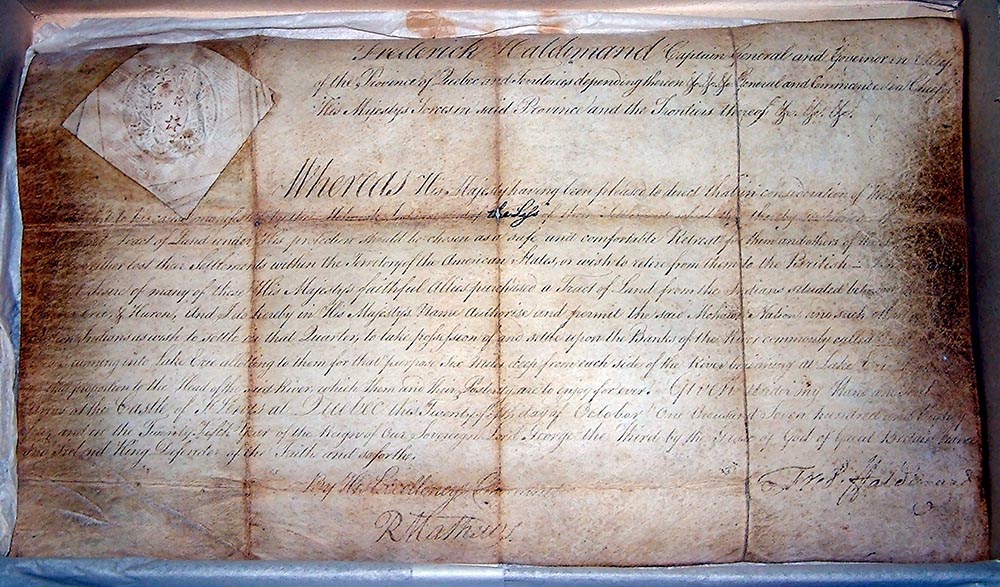
THE STORY
Although the Iroquois nations had officially declared neutrality during the Seven Years War between Britain, France and Spain — and the war concluded with the Treaty of Paris in 1763 — tensions were now rising in between British loyalists and American rebels along the Mohawk Valley around 1775 in what would soon become the Revolutionary War.
THE PROBLEM
The British knew that they needed the help of indigenous warriors in order to fight. A Grand Council was called at Montreal between the British and as many “Canadian” Indians as they could rally. It was held in Montreal from July 26-29, 1775 and included 1700 Indigenous representatives — from the Caughnawagas, the Mississaugas, the Seven Nations of Canada (the Mohawks of Akwesasne, Kahnawake, Kanesatake, Oswegatchie; and the Abenakis, Mi’kmaqs and Hurons of Odonak, Becancour and Jeune Lorette) and the Six Nations Iroquois.
THE PROMISE
It was at this Great Council in Montreal, 1775, where Sir Guy Carleton, then Governor General of British North America, made a promise to all those nations in attendance. Joseph Brant said, “Upon our arrival there [Montreal], this conduct was approved of by Sir Guy Carleton, who, in a public Council, desired us to take up the hatchet and defend our country, and that any losses we might sustain by the war, he promised should be replaced.”
THE REVOLUTIONARY WAR
Joseph Brant, also known as Thayendaneagea, led a band of 100 men called “Brant’s Volunteers” to wage war on rebel villages. They were a ferocious guerrilla company of men made up of 20 Mohawk warriors and 80 British Empire Loyalists who viciously destroyed rebel villages as part of the battle for territory. This earned him the nickname “Monster Brant”.
THE TRIP TO ENGLAND
Lord Dartmouth, Britain’s colonial secretary, had asked for a list of the Indian’s grievances. It was a timely request as the notorious rebel, Ethan Allen, who had been destroying loyalist villages in the Mohawk Valley and throughout New York had just been apprehended and was set to be transported to prison in Cornwall, England. Joseph and another Mohawk, John Hill Oteronyente were selected as speakers for the Indigenous nations and set sail on the Adamant on November 11, 1775. Joseph and John were presented to His Majesty George III on February 29, 1776 at St. James Palace. The two returned to Turtle Island in June 1776 having made an impression upon nobility and established a platform for the Indigenous people.
THE WAR
The Revolutionary War waged on and in the process several villages of the Iroquois had been destroyed and the people were impoverished. To make things worse, in 1777 the situation among the Iroquois Confederacy was a disaster. A series of deaths and disease among the Onondagas led to a ceremonial extinguishing of the Grand Council Fire; the Oneidas sided with the American rebels and at the Battle of Oriskany a great fight broke out between pro-rebel and pro-loyalist Iroquois ending in Mohawks and Oneidas killing one another.
THE PLEDGE
In 1779, the war was raging on and the Mohawks were seeking confirmation from the new Governor General, Sir Fredrick Haldimand, that the PROMISE of 1775 made by Sir Guy Carleton would be honoured. Haldimand then issued the Haldimand Pledge on April 7, 1779 — naming three Mohawk villages that had been destroyed: Canojarharie, Ticonderago, and Aughugo. Also known as the Canajoharie, Fort Hunter and Oquaga. The people from these villages had been left homeless and the Six Nations wanted to know that they would have somewhere to go after the war. Haldimand ratified Carleton’s earlier promise and said that all villages destroyed by the rebels during the war would be restored at the expense of the Government once the fighting was over.
THE GENOCIDE
The fighting would continue through 1779 with the Sullivan Campaign, direct orders from George Washington who ordered rebel forces to launch a scorched earth campaign and burn and eradicate all Iroquois villages and all cornfields. The result was the complete destruction of the Iroquois homes and economies. It was a harsh winter between 1779-1780 that the Iroquois spent as refugees in camps surrounding Fort Niagara.
THE END OF THE WAR
The British ceded to the Americans and the United States had to enter into treaties with the Indigenous people to settle terms for peace. The Treaty of Fort Stanwix was finalized on October 22, 1784 between the Americans and the Iroquois — signed by Cornplanter and Captain Aaron Hill. The treaty was rejected by the Iroquois Council at Buffalo Creek as it divided their territories and they said those who signed it did not have authority to surrender lands required to settle the terms of the treaty.
THE PROCLAMATION
The Haldimand Proclamation was a decree made by Sir Fredrick Haldimand on October 25, 1784, granting land to “the Mohawk Nation and Such Others” to settle along the Grand River, six miles deep of lands on either side of the River, in lands north of the Great Lakes. The Proclamation was viewed as the fulfillment of Haldimand’s earlier Pledge in 1779 and the Promise made by Sir Guy Carleton. It was signed in Quebec at the Chateau St. Louis, the official home of the Governor General — the same site as the Promise and Pledge were made. Historical documents show people allied to Brant would begin to settle along the Grand in 1783. By the year 1817 the area had recorded 1800 Iroquois, 430 white loyalists and 30 black folks.






